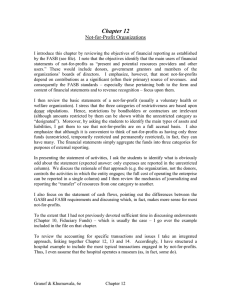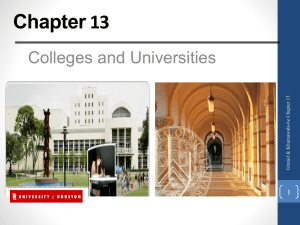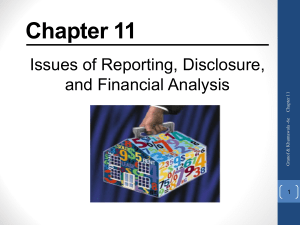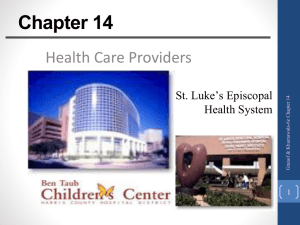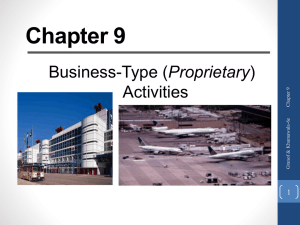Chapter 12
advertisement
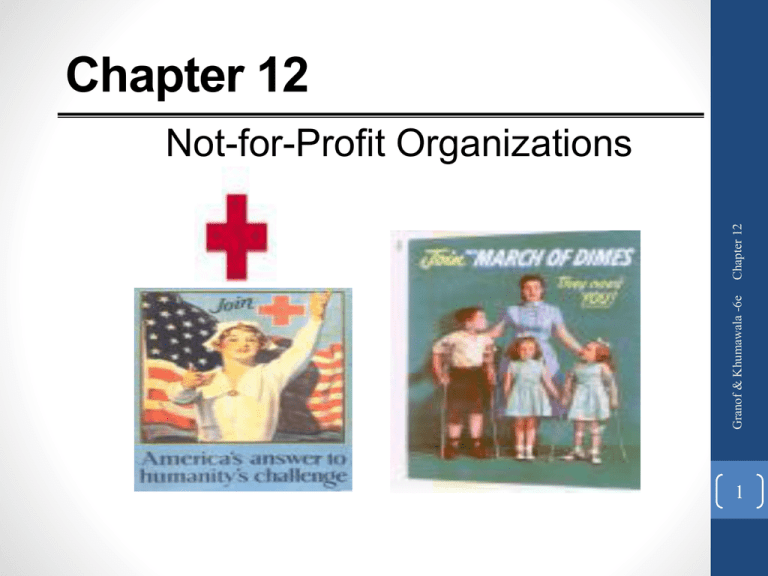
Chapter 12 Granof & Khumawala -6e Chapter 12 Not-for-Profit Organizations 1 “Service to others is the rent you pay for your room here on earth.” Mohammed Ali Granof & Khumawala -6e “We make a living by what we get. We make a life by what we give.” Winston Churchill Chapter 12 Thoughts to Ponder 2 Granof & Khumawala -6e Chapter 12 Life’s Lessons : Chapter 12 3 Learning Objectives Identify the authoritative standards-setting bodies for establishing GAAP for Not-For-Profits (NFPs). • Explain financial reporting and accounting for NFPs: o Contributions, contributions of services, pass through contributions o Pledges o Collection Items o Gains and losses on Investments o Fixed Assets • Special problems of determining the cost of fund-raising activities • Assessing the financial conditions of NFPs’ Granof & Khumawala -6e • Reporting of Cash Flows by NFPs Chapter 12 • Division of Resources into: o Unrestricted o Temporarily restricted o Permanently 4 How to determine whether it is a ‘Nongovernmental NFP’ or ‘Governmental Entity’ • It was not created by a government, but rather by individuals. • FASB is the authoritative standards-setting body for financial reporting, not the GASB. • Examples of not-for-profit organizations: March of Dimes, American Red Cross, etc. o March of Dimes’ mission is to improve the health of babies by preventing birth defects, premature birth, and infant mortality. Granof & Khumawala -6e • It may not have the power to levy tax-exempt debt. Chapter 12 • It does not have the power to levy taxes. o American Red Cross works to provide relief to victims of disasters and help people prevent, prepare for, and respond to emergencies. 5 Governments Vs. Non-profits Granof & Khumawala -6e • FASB: sets standards for non governmental nonprofits except federal government. Chapter 12 • GASB: sets standards for all state and local governmental entities (including governmental nonprofits). 6 A wide variety of entities! • Some non-profits are hybrids: o Funding derived from both exchange & nonexchange transactions. Ex. colleges and universities. Granof & Khumawala -6e • Some not-for-profits are comparable to business. o Funding derived from exchange transactions. Ex. Hospitals, nursing homes, child care centers. Chapter 12 • Some not-for-profits are like governments. o Funding derived from non-exchange transactions. 7 Granof & Khumawala -6e • Accounting is where the nonprofit buck stops. Accounting gives the nonprofit a key tool to run its business, plan its future, and show donors and regulators it is spending and tracking its funds the way it should (management tool for protection and efficient use of assets to accomplish mission) • Tax/regulatory compliance o Maintain tax exempt status o Reporting (Form 990, 990-PF, 990-T as well as state and local compliance) o Payroll • Grant compliance • Transparency Chapter 12 Importance of Not-For-Profit Accounting 8 Granof & Khumawala -6e Accountant and attorney fees saved . . . Thousands of dollars Avoiding sanctions on officers . . . Penalty up to 200% of excess benefit plus Repayment Keeping exempt status so you can accomplish your mission . . . Priceless! Chapter 12 What are the benefits of sound accounting policies and procedures? 9 AICPA Audit and Accounting Guide Not-for-Profit Organizations (AAG-NPO, revised 2012) Granof & Khumawala -6e FASB Statement (SFAS) No. 93 — Depreciation FASB Statement (SFAS) No. 95 — Stmt of cash flows FASB Statement (SFAS) No. 116 — Contributions FASB Statement (SFAS) No. 117 — Financial statement display FASB Statement (SFAS) No. 124 — Investments FASB Statement (SFAS) No. 136---Transfers of assets FASB Statement (SFAS) No. 164 – NFP entities: Mergers & Acquisitions Chapter 12 GAAP for Nongovernmental NFPs 10 Granof & Khumawala -6e Required • Statement of financial position • Statement of activities (change in net assets) • Statement of cash flows • Amounts of each of three classes of net assets permanently restricted, temporarily restricted, and unrestricted – be displayed in statement of financial position • Amounts of change in each of the three classes of net assets be displayed in the statement of activities Chapter 12 SFAS 117: Financial Statements of Not-for-Profit Organizations 11 Financial Statements for NFPs 1. Statement of Activities (Table 12-2) 4. Notes to the Financial Statements 5. Statement of Financial Position (Table 12-1) Example on next slides: Christopher Reeve Foundation Granof & Khumawala -6e 3. Statement of Cash Flows (Table 12-4 and 12-5) Chapter 12 2. Statement of Functional Expenses (Table 12-3) 12 13 Granof & Khumawala -6e Chapter 12 14 Granof & Khumawala -6e Chapter 12 15 Granof & Khumawala -6e Chapter 12 16 Granof & Khumawala -6e Chapter 12 17 Granof & Khumawala -6e Chapter 12 18 Granof & Khumawala -6e Chapter 12 19 Granof & Khumawala -6e Chapter 12 Granof & Khumawala -6e Not all nonprofits include full financial statements in their annual report – Below are the condensed financial statements of March of Dimes Foundation Chapter 12 Popular Reporting 20 FASB and GASB standards differ on these issues: • Investments • Cash flows • Pensions • Compensated absences • Operating leases Granof & Khumawala -6e • Reporting entity Chapter 12 • Financial statement display • Risks and uncertainties 21 • Net Assets (assets less liabilities) must be classified as either: 1) unrestricted OR 2) temporarily restricted OR 3) permanently restricted Classifications are based on the existence or absence of donor-imposed restrictions. • As long as net assets are classified, there is considerable flexibility in displaying information including showing disaggregated fund-based data Granof & Khumawala -6e • Reports on an aggregate view of the entity as a whole, rather than on disaggregated funds, as of a point in time. Chapter 12 I) Statement of Financial Position FASB Statement No.117 22 Granof & Khumawala -6e Chapter 12 March of Dimes 23 Granof & Khumawala -6e • FAS125 (similar but simpler than FAS115) More similar to GASB than to For-Profit rules! • Fair value accounting for all investments • Gains and losses always impact “bottom line” Chapter 12 Investments 24 Investments GAAP: FASB Statement No. 124 • SFAS No. 124 requires extensive disclosures regarding investments and related income. Granof & Khumawala -6e • Similar to SFAS No. 115 for businesses and GASB Statement No. 31 for governments, but simpler. Chapter 12 • Mark equity investments that have readily determinable values and all debt securities to fair value. 25 II) Statement of Activities FASB Statement No.117 b) Expenses c) Gains/losses d) Contributions (Support) When net assets are released from restrictions (as restrictions are met), it causes both, 1) Decrease in temporarily restricted net assets AND 2) Increase in unrestricted net assets Granof & Khumawala -6e a) Revenues Chapter 12 Reports on changes in all classes of net assets for a period of time. Changes take the form of: 26 II) Statement of Activities (Cont’d) FASB Statement No.117 1) A single column (March of Dimes) OR 2) Three columns (Red Cross) Additional classifications to be used in addition to unrestricted, temporarily restricted, & permanently restricted. Examples include: • operating and non operating • expendable and nonexpendable • earned and unearned • recurring and nonrecurring Granof & Khumawala -6e Considerable flexibility in presenting Statement of Activities information Most commonly used presentations include: Chapter 12 SFAS No. 117 allows: 27 Granof & Khumawala -6e • Revenues are increases in unrestricted net assets that arise from bilateral exchange transactions in which the other party receives direct tangible benefits commensurate with the resources provided. o Examples include: membership dues program service fees sales of supplies and services investment income some grants • Revenues should be reported as increases in one of the 3 categories of net assets. Chapter 12 a) Revenues 28 • Record depreciation expense for all capital assets, except collections. Granof & Khumawala -6e • Use accrual accounting. • All should be reported as decreases in unrestricted net assets. • Should be reported by functional categories (i.e. program vs. support) Chapter 12 b) Expenses 29 Salaries Grants Made Granof & Khumawala -6e Chapter 12 Each expense is coded two ways – “object” versus “function” Salaries Depreciation Utilities 30 • Criteria to be applied includes considering 1) Purpose 2) Audience 3) Content Granof & Khumawala -6e • Reported as fund-raising support expenses, rather than allocate to functional programs, such as education or advocacy Chapter 12 Joint Costs with a Fund-raising Appeal AICPA SOP 98-2. 31 32 Granof & Khumawala -6e Chapter 12 c) Investment Gains/Losses • Should be included separately from Revenues & Expenses. • Report realized and unrealized investment gains/losses. o GAINS/LOSSES on sale or disposal of equipment • Report income and GAINS and LOSSES as changes in unrestricted net assets, unless their use is restricted by the donor or state law. • Donors may stipulate that a portion of appreciation is to be permanently restricted to maintain the purchasing power of the endowment. • If a donor is silent as to LOSSES: A) they reduce unrestricted net assets if the net appreciation requirement has been reached OR B) Otherwise they reduce temporarily restricted net assets. • GAINS: o Relate to peripheral or incidental transactions of the entity o Often are beyond the control of management Granof & Khumawala -6e o realized GAINS/LOSSES on investment transactions Chapter 12 Examples include: 33 Granof & Khumawala -6e • Applies to all entities receiving or making charitable contributions • Generally, contributions received, including unconditional promises to give, are recognized as revenues in period received at their fair values. • Generally, contributions made, including unconditional promises to give, are recognized as expenses in the period made at their fair values. • Conditional promises to give are recognized when they become unconditional, i.e. when conditions met. Chapter 12 SFAS 116: Accounting for Contributions Received and Contributions Made 34 • Recognition of expiration of donor-imposed restrictions in the period they expire. Granof & Khumawala -6e • Contributions received increase o Permanently restricted net assets o Temporarily restricted net assets o Unrestricted net assets Chapter 12 SFAS 116, Continued 35 d) Contributions FASB Stmt. No 116 Granof & Khumawala -6e • Contributions are increase in net assets arising from contributions of resources in non exchange transactions in which the donor derives no tangible benefit from the recipient agency. (i.e. Nonreciprocal Receipts of Assets/Services) --Compare this definition to “Revenue” on earlier Slide Chapter 12 • Contributions are the main means of support in NFP’s 36 d) Contributions (cont’d) FASB Stmt. No 116 • Permanently restricted net assets when the donor stipulates that the assets must be held in perpetuity, but the organization can spend the income. Granof & Khumawala -6e • Temporarily restricted net assets when the donor imposes restrictions as to purpose (how the asset is used) or time (when the asset is used). Chapter 12 Contributions Increase: • Unrestricted net assets when no donor restrictions exist or the restrictions have expired. 37 • Depend on the occurrence of a specified future and uncertain event to bind the promissor, such as obtaining matching gifts by the recipient. • Do not record these as support until the conditions are substantially met. Donated material (gifts-in-kind): • should be recorded as contributions and as expenses (supplies expense or cost of goods sold) • at fair value on the date of the gift • if an object, clearly measurable basis for fair value can be established. Purpose-Restricted Contributions: • Equivalent to government’s restricted grants. • Used only for donor-specified purposes. Granof & Khumawala -6e Unconditional promises (“Pledges”): • Depend only on the passage of time or demand by the promisee for performance. • Record these as support in the period made. Conditional promises: Chapter 12 d) Contributions (cont’d) FASB Stmt. No 116 38 d) Contributions (cont’d) Unconditional Promises (“Pledges”) • Definition: o Promises to make donations of cash or other assets. • Legally enforceable if donor reneges? o Pledges are enforceable when the organization has relied on the pledge and thereby incurred costs. o However, from a practical standpoint, legal action will rarely be taken by a NFP. Granof & Khumawala -6e o PRIOR to Statement released: Revenue recognized when pledges received o AFTER Statement released: Revenue not recognized until cash has been collected More conservative approach Chapter 12 • FASB Stmt. #116: 39 • FASB Stmt. # 116: o conditional promise shall be recognized when the specified conditions are met Granof & Khumawala -6e • Definition: o Specific conditions have to be satisfied for the donor to provide the resources. Chapter 12 d) Contributions (cont’d) Conditional Promises 40 d) Contributions (cont’d) Contributed Services FASB Stmt. # 116: • Contributed Services recognized only if they are of: o professional nature o the entity would have paid for it if it had not been donated. Granof & Khumawala -6e A) create or enhance non financial assets (such as a carpenter constructing a building), OR B) are provided by individuals possessing specialized skills that typically would need to be purchased if not provided by donation (e.g., secretaries or accountants). Chapter 12 Contributed services should be recorded as contributions and expense (salaries expense) at fair value if the services: 41 Granof & Khumawala -6e American Red Cross: • The organization recognizes contributions, which include unconditional promises as revenues in the period received or promised. • The organization reports contributions in the temporarily or permanently restricted net asset class if they are received with donor stipulations. • When the stipulated time ends, then it is reclassified from restricted to unrestricted net assets in the consolidated statement of activities. • Products and services revenue, which arises from sales of whole blood and components, and plasma derivative products, and health and safety course fees, is generally recognized upon delivery of products and services to the customer. Chapter 12 d) Contributions (cont’d) American Red Cross 42 III) Statement of Functional Expenses Voluntary health and welfare organizations (VHWOs) must present this statement showing both functional expenses and natural (object or line item) expenses Functional Expenses Program Salaries Adoption Supplies Counseling Depreciation Education Support Mgmt and General Granof & Khumawala -6e Natural Expenses Chapter 12 (Table 12-3). Fund-raising 43 IV) Statement of Cash flows FASB Statement No. 95 • The indirect method or direct method (with reconciliation) may be used. Granof & Khumawala -6e • Cash flows are reported as changes in operating, financing and investing activities (Table 12-5). Chapter 12 • SFAS No. 95 was amended to extend coverage to not-for-profit organizations as well as for-profit entities (Table 12-4). 44 • REMEMBER: GASB requires that cash flow statements be categorized into: I) Operating activities II (a) Non capital financing activities II (b) Capital and financing activities III) Investing activities • It also mandates that governments use direct method to report cash flows. Granof & Khumawala -6e • FASB requires that cash flow statements includes: I) Operating activities II) Financing activities III) Investing activities Chapter 12 IV) Statement of Cash flows FASB Statement No. 95 45 IV) Statement of Cash flows Miscellaneous Accounting Reminders • Noncash gifts or in-kind contributions are disclosed as noncash investing and financing activities in a separate section. Granof & Khumawala -6e • Restricted contributions given for long-term purposes are included with financing activities along with the related income. Chapter 12 • Unrestricted gifts are included with operating activities. 46 • • • • Liquidity: --Quick ratio and Current ratio Burden of debt: Total debt/Total assets Adequacy of available resources: shows extent of organization’s reserves. Current fiscal performance: extent of operating surpluses or deficits. Reliability of budgetary projections Proportion of revenues directed to the organization’s mission 4 important ratios: o o o o Fund raising ratio: fund-raising expense measured as a % of total related revenues. Program ratio: compares expenses of mission-oriented programs to administrative costs. Contributions and grant ratio Revenue from services ratio Granof & Khumawala -6e • • • Chapter 12 Additional Topics-Financial Indicators 47 • FASB Stmt. No. 117 Permits NFPs to present disaggregated data classified by fund groups, as long as the aggregated net asset statements are also presented. Granof & Khumawala -6e • NFPs may use fund accounting for internal purposes to facilitate reporting back to grantors or funding agencies. Chapter 12 Optional Fund Accounting 48 Optional Fund Accounting AICPA AAG-NPO pars. 16.01 -16.20 • Plant funds (or land, building, and equipment funds) • Loan funds (most often in private universities) • Endowment funds. Granof & Khumawala -6e • Restricted current funds (or restricted operating or specific purpose funds) Chapter 12 • Unrestricted current funds (or unrestricted operating or general funds) • Annuity and life income funds (or split-interest funds) • Agency funds or (custodian funds). 49 Granof & Khumawala -6e • FASB sets accounting standards for Not-for-Profits (NFPs) other than governments. Thus they follow the full accrual basis of accounting. • NFPs should classify their resources into three categories: unrestricted, temporarily restricted and permanently restricted. • NFPs should recognize as revenue all unconditional contributions including both pledges and restricted donations when they are received. • NFPs should recognize contributed services only if they are of a professional nature and would be required by the NFP if not donated. • NFPs are not required to recognize and capitalize works of art. • NFPs like governments face special problems of accounting for pass-through grants and contributions. • NFPs follow AICPA’s SOP 98-2 to allocate joint costs that have a fund-raising appeal. • The Fiscal health of an NFP can be assessed using traditional financial ratios. Chapter 12 Summary 50
